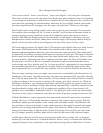
5) GAIN. This sets the boost and/or cut depth or amount and works with the BOOST, OUT, CUT, TOGGLE. FLAT is fully
counter-clockwise not straight up "12:00" like most EQs. It is more like a Pultec in this regard. Maximum boost or cut is fully
clockwise and can be up to 20 dB - but not necessarily. There is a fair amount of interaction with the BANDWIDTH control.
The maximum of 20 dB is available in Shelf modes when the Bandwidth is CCW and is about 12 dB when the Bandwidth is CW.
The maximum of 20 dB is available in Bell modes when the Bandwidth is CW and is about 6 dB when the Bandwidth is CCW.
At straight up "12:00" in Bell mode "narrow" expect about 8 dB of boost or cut. In other words, you shouldn't expect the markings
around the knob to indicate a particular number of dBs. Many Eqs are this way. On the other hand, this interaction is the result
of natural interactions between components and tends to "feel" and sound natural as opposed to contrived.
The 2 bands will have some interaction and interdependence especially when both are set towards mid frequencies. It is a parallel
EQ rather than the far more common series connected style. If you set up all 2 bands to around 1kHz and boosed each 20 dB,
the total boost will be 20 dB rather than 40dB (20+ db of boost and 20 dB into clipping). This also implies, that if you first boost
one band, that the next will not seem to do much if it is at similar frequencies and bandwidths. Virtually all other parametrics
are both series connected and designed for minimal interaction, which seems to be quite appealing if you wear a white lab coat
with pocket protectors ;.) Actually, there are valid arguements for those goals and there are definately some applications that
require them. However, there is also a valid point for an EQ that is substantially different from the "norm", and for audio toys
that have artistic merit and purpose and not just scientific interest or gimmickry. We tried to balance artistic, technological and
practical considerations in both the Massive Passive and Mini Massive, and offer both some new and old approaches that appealed
to the ears of recording engineers (and our own ears).
6) BANDWIDTH. Similar to the "Q" control found in many EQs. A more accurate term here would be "Damping" or
"Resonance" but we used "Bandwidth" to stay with Pultec terminology and because it is a "constant bandwidth" (*) design rather
than "constant Q" and because of the way it uniquely works in both Bell and Shelf modes. In Bell modes, you will find it similar
to most Q controls with a wider shape fully CCW and narrower fully CW. The widest Q (at maximum boost) is about 1 for the
and the narrowest Q is about 2.5 to 3 for most of the frequencies. On paper, the bell widths appear to have less effect than is
apparent on listening and the sound is probably more due to "damping" or "ringing" and the way it interacts with the gain. Also
some people associate a wide bell on conventional EQs with more energy boost or cut, and at first impression the Massivo seems
to work backward compared with that and narrow bandwidths give more drastic results. On the Massive Passive a narrow
bandwidth bells will allow up to the full 20 dB of boost (or cut) and wide bandwidths significantly less at about 6 dB maximum.
In Shelf Modes the Bandwidth has a special function. When this knob is fully CCW, the shelf curves are very similar to almost
all other EQs. As you increase the Bandwidth control, you begin to introduce a bell curve in the opposite direction. So if you
have a shelf boost, you gradually add a bell dip which modifies the overall shelf shape. At straight up, it stays flatter towards the
mid range, and begins to boost further from the mids with a steeper slope but the final maximum part of the boost curve stays
relatively untouched. With the Bandwidth control fully CW, that bell dip becomes obvious and is typically 6dB down at the
frequency indicated. The boost slope is steeper and the maximum boost may be about 12 dB. These curves were modelled from
Pultec EQP1-As and largely responsible for the outrageous "phatness" they are known for. As you turn the Bandwidth knob (CW),
it seems as if the shelf curve is moving further towards the extreme frequencies, but mostly of this is just the beginning part of
the slope changing and not the peak. This also implies, that you may find yourself using frequencies closer to the mids than you
might be used to. These shelf curves have never been available for an analog high shelf before and provide some fresh options.
7) FREQUENCY. Each band provides a wide range of overlapping and interleaving frequency choices. Each switch position
is selecting a different capacitor and inductor. In fact, in SHELF mode the EQ could be deemed third order sections, which implies
3 frequency dependent components are in play, 2 capacitors and an inductor or two inductors and a capacitor. Normal shelf EQs
are first order with only one capacitor creating the EQ shape, and this shape is less steep and controllable by the user.
At extreme high and low frequencies (including 10K and 12K), you might get some unexpected results because of the Bandwidth/
Shelf function. For example, you can set up 20 dB of boost at 12K and it can sound like you just lost highs instead of boosting.
This happens when the Bandwidth control is more CW only and not when it is CCW. Why? You are creating a dip at 12K and
the shelf is only beginning at the fringes of audibility but the dip is where most of us can easily percieve. It takes a little getting
used too the way the controls interact. The reverse is also true, where you set up a shelf cut and you get a boost because of the
Bandwidth control being far CW. In some ways this simulates the shape of a resonant synthesizer filter or VCF except it doesn't
move. These wierd highs are useful for raunchy guitars and are designed to work well with the Filters. There are a lot of creative
uses for these bizarre settings including messing up the minds of back-seat engineers.
6


















